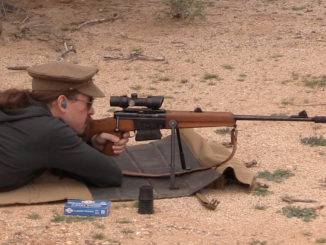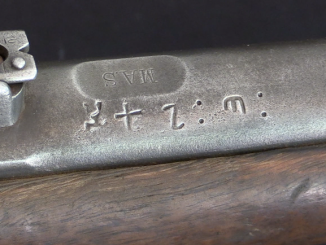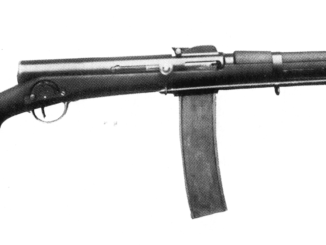This is a commercial pump-action shotgun manufactured in France and proofed at the St Etienne proof house. I know basically nothing else of its provenance, including who designed it, who sold it (although I would assume Manufrance…) or when it was in production (assuming it did get into serial production). What I do know is that it has a quite unusual and very interesting operating mechanism, and I wanted to take my limited access with it to at least show you that!
Thanks to Ader of Paris for the chance to film this very cool piece of firearms history.




Sometimes I feel so sorry for the gun, that nobody remembers it, and that it will never be fired again, it will simply be a non-working hunk of metal in a museum forever.
Now billions will remember thanks to Gun Jesus…
See Small Arms of the World, 9th ed., 1969, p.77 top. The feed mechanism and searage closely resemble that of the early Schulhof magazine rifle.
Note that the Schulhof tubular magazine had no follower or spring, but instead was fed by a rail with a series of “keepers” which pushed the rimmed cartridges up onto a lifter very much like the arrangement seen in this action.
The Schulhof bolt action was a straight-pull with a flap lock, and a striker-fired searage operated by a thumb trigger (to avoid having to work around the tubular magazine). What appears to be a hammer at the rear of the firing mechanism is simply the cocking piece to draw the striker back to be held by the sear.
I would suggest that this shotgun was based on the Schulhof system, possibly as a way of making some money on it commercially after it was rejected as a military rifle. But that’s simply a SWAG.
cheers
eon
This magazine placement reminded me experimental 1892 Clair automatic pistol, see cut-away drawing https://www.historicalfirearms.info/post/89393190878/pistolet-clair
it is straight rather than curved and has spring, but freres Clair did experiment long years https://www.smallarmsreview.com/display.article.cfm?idarticles=1822 so I would not rule out, they might try non-spring magazine.
Also they were linked with city of Saint-Étienne (there existed Clair Constructeur Mécanicien Fabricant d’Armes in Saint-Étienne).
Quite a few early European bolt-action military repeater designs had tubular magazines in the stock, notably the Mannlicher. On this side of the Atlantic, other than the Spencer and Hotchkiss, a tubular magazine was more likely to be beneath the barrel.
The reasoning in Europe early on seems to have been to keep the forearm as slim and light as possible as well as to avoid potentially damaging the magazine when using the bayonet.
In the end, of course, the underbarrel tubular magazine proved to be the better alternative as long as the designer was dealing with largebore rimmed blackpowder cartridges, hence the Mauser 71/84, Kropatschek, etc.
The Lebel 8 x 50Rmm was apparently the last major design to use such a magazine, and as it was chambered for a high-velocity bottlenecked smallbore round (for its era) with a pointed bullet, some tricky cartridge design was required, i.e. the annular “trough” in the case head to keep the bullet tip away from the primer of the round ahead of it.
The one place there seems to have been little or no interest in the tubular magazine was Britain. Other than a very few sporting designs like the Needham, there were apparently no attempts at a tubular magazine repeater for military purposes.
This was likely due to the fact that the British Army had no particular interest in a repeating rifle, period, due to the horror of “wasting ammunition”.
As such, the British Army went straight from the largebore single-shot to the smallbore box magazine repeater (the original “Long Lee”), bypassing the “largebore tube magazine repeater age” completely.
cheers
eon
Wonderful video.
Very nice review. Thank you.
Very interesting, Ian. This is why we pay you the “big bucks”. ; ) Merry Christmas to you & yours.
If I still had my Alfa catalog I would be thumbing through it right now…
Someone commented with this link then deleted it on YouTube, but I think they were right, it looks to a prototype related to this rifle. The magazine tube looks identical.
http://www.aiolfi.com/vente/1478-automne-2019-ventes-dobjets-militaires-et-de-souvenirs-historiques/1601-collection-pierre-rolly/1676-fusils-de-chasse/prototype-de-fusil-de-chasse-mono-canon-semi-automatique-3/#tab_description
Yes that item at aioli.com does seem to be a very close match – same bore, similar markings but also with e letters BC and the number 5 and the (French) description seems to say that those could perhaps refer to e initials of Benoit Clair. Ian should have a look …
I have a number of catalogs of the Manufacture d’armes et cycles de St Etienne and never saw such a thing. It would have been stamped accordingly if sold by the Manuf’. Manufance is a late name legally , from 1979 to the end in 1986, and reborn. If tired to say the full manufacture d’armes …..and so on, one can say La Manuf’.
Thanks for the video, very instructive. Note: The 17.0 marking is the regular diameter of a 16 gauge barrel in metric measurement.
In the metric system, 16ga is 16,8-17,2 mm.
I think “17” is the muzzle choke diameter or the actual barrel bore diameter.
This is important for bullet shooting.
France and especially the area around st. Etienne had a lot of local gunsmiths makiing one off prototypes before WW1 and between the two wars. Some of these bizarre weapons were manufactured in quantity For an example look at the twist barrel single shot RAFALE shotgun made by the Manu
If you have to pull the trigger to cycle the shotgun, does that mean you can’t unload a loaded gun? (I didn’t watch the retirement film)
Please watch the entire episode before commenting. In this instance, no, it doesn’t mean that you can’t unload the gun. You put the gun on safe. Then pulling the trigger releases the bolt, but the firing pin is not actuated.
entire film**?
Watching the clip or reading the article?
Why, that would violate the best internet standards and practices!!
MADNESS!